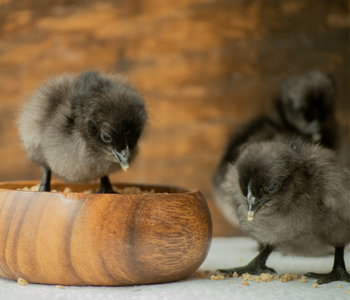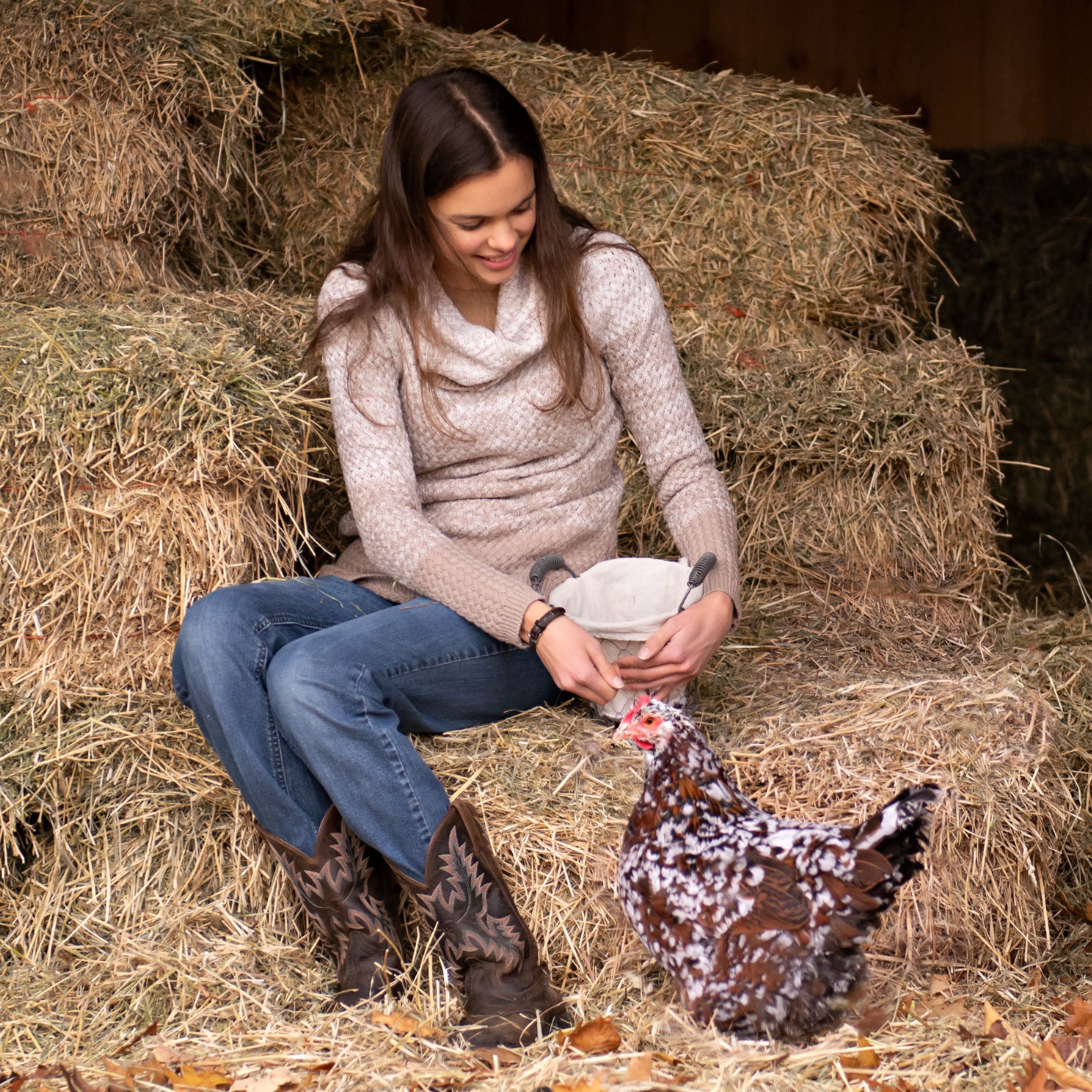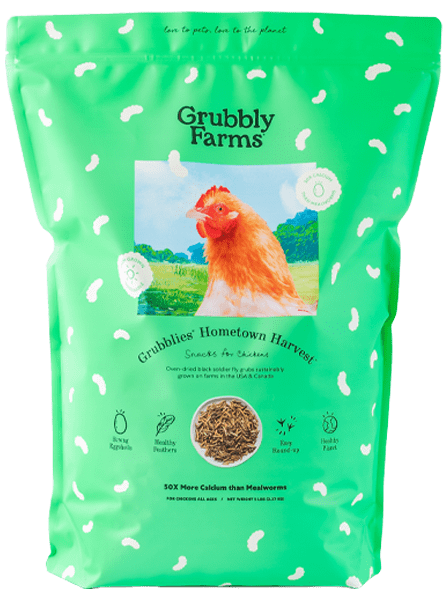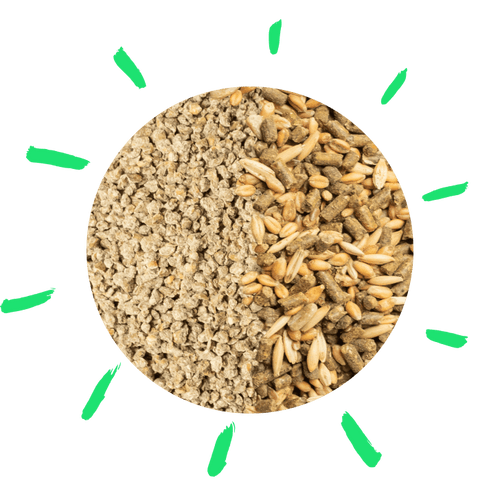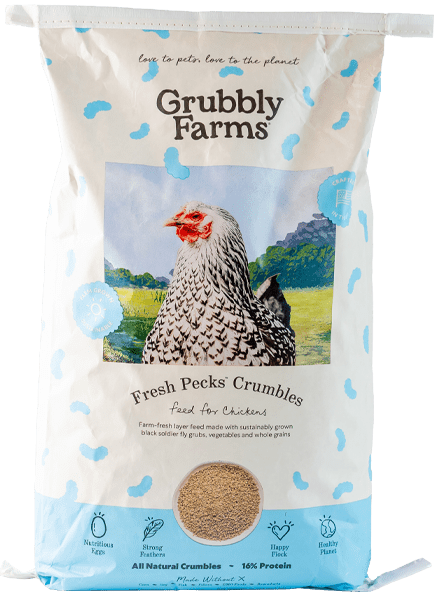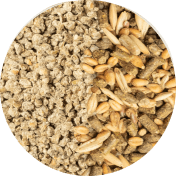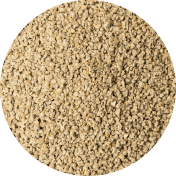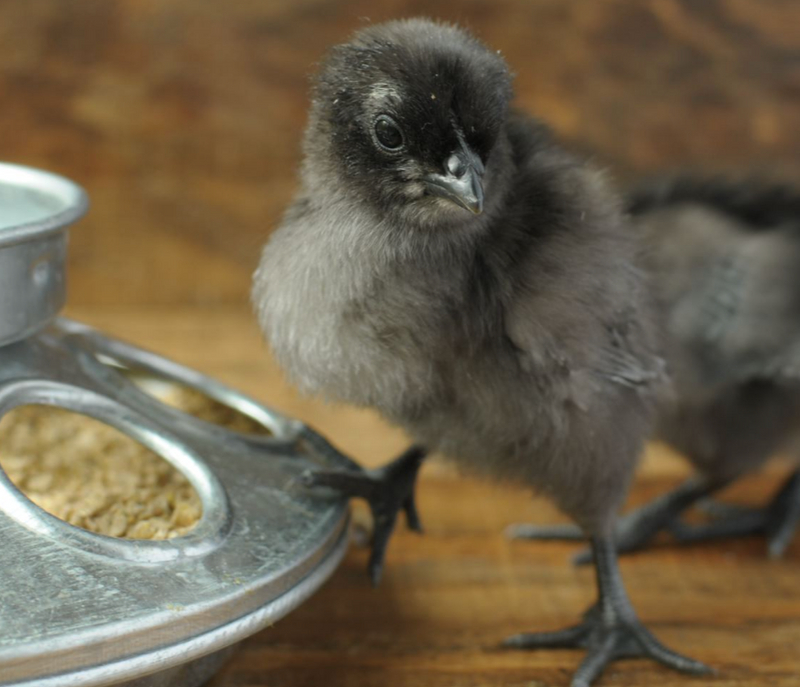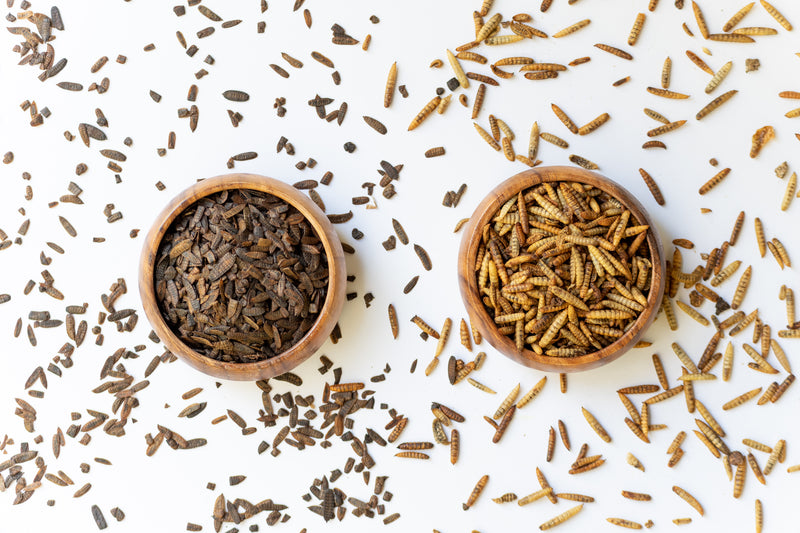Food is the fuel source for growing baby chicks! It would only make sense then that your chicks will grow and mature according to what they eat and how they are fed. Grubbly Little Pecks Starter Grower feed (for chicks ages 0-20 weeks) is an excellent choice for a well-balanced, nutrient-dense, high protein feed for your baby chicks! The crumbles are packed with insect protein and plants (foods they naturally love to eat). How do you teach your babies to eat it? What should you do as they grow? When do you switch from chick starter to grower feed and how? Here are 5 essential tips for feeding your chicks to ensure your little ones get off to a great, healthy start.
Be sure to download our printer-friendly feeding guide here: Grubblys_Feeding_Guide_for_Chicks.pdf

#1. Food Placement
The first thing you should consider is where to place the food in the brooder. The food should be contained in a proper chick feeder that is easy for the chicks to eat out of and keep the food clean and moisture free. Considering where the feeder should be placed in the brooder is important for the health and well-being of your chicks.
For the first day, you will want the feeder placed fairly close to the heat source. The chicks will just be learning the layout of their new home, and super young chicks (day old chicks or younger) will likely not venture away from the heat to look for food. Having their food near the heat source for the first day of your chicks’ arrival will allow them to have easy access to their food as they adjust to their new surroundings.
After your chicks have become accustomed to their new home and are confident in their brooder, you can move the food away from the heat source and place it near the water source. Having both the food and water away from the heat source encourages the chicks to leave the supplemental heat, which in turn ensures proper development and growth.
You should have feeder placement all figured out before welcoming home your chicks. Once you have an idea about where the food should be placed within the brooder, it’s time to introduce the chicks to their food source!

#2. Introducing Food
Whether you’ve mail ordered your chicks, brought them from a farm store, or hatched them in an incubator, as soon as those little fluff balls enter the world, it’s time to teach them the basic needs of survival: where to find food, water, and warmth.
While water is of utmost importance, and should be introduced first, food is equally important and should be introduced right after water.
Before welcoming home chicks, you should have the brooder all set up and ready to go. The feeder should be filled with your Grubbly Little Pecks Starter Grower feed, the waterer should be full of probiotic water, and the heat source should be turned on. Now, depending on how old the chicks are when you acquire them will depend on how you introduce them to food.
For chicks who are newly hatched or only a day old and have never seen food before, you will have to be the one who shows them what is good to eat. You should have the brooder set up with paper towel litter so as not to distract from the food. Sprinkle some of the feed around the feeder, then place the chicks near the food crumbs. Use your finger and pretend to ‘peck’ at the food crumbs. Chicks are naturally curious and will quickly learn what their food looks like and where to find it. Once you have shown the chicks what food looks like, you can then teach them where to find more food at the feeder.
For chicks who are over a day old and have already been introduced to food (such as chicks bought from the farm store), you have to show them where to find their new food and direct them to the feeder. Of course, if the food looks different than what they were previously fed, you may need to introduce them to the new food and show them that it is what they are supposed to eat.
Learning what to eat and where to find food are some of the first things you should teach your chicks when you get them! Sprinkling food around the feeder, placing the chicks near the feeder, or pretending to ‘peck’ at the food yourself are great ways to teach baby chicks about their food source!
The chicks should have access to their food at all times so that they can fuel up throughout the day and learn the natural foraging behavior of eating small meals every hour of the day. This is called free-choice feeding and it allows the chicks to consume the amount of food they need throughout the day. They don’t need a fixed feeding schedule like other baby animals!
#3. As They Grow
The chicks are off to a great start! They know what to eat and where to find it, now what? As the chicks grow, their feeding needs will change slightly. Generally, chicks are started off on a starter feed, then switched to a grower feed when they are a few weeks older. However, some feeds, like Grubbly Little Pecks Chick Starter Grower, remove the need to make a feed switch by providing an all-in-one feed that will provide the proper nutrition for your chicks all the way through their growing stage!
Even though you won’t have to switch feeds, there are still some considerations to make as your chicks grow and their feeding needs change. After the first few days you will have moved the feeder away from the heat source. After that, you shouldn’t have to do too much rearranging unless you switch to a different feeder or move the chicks to a larger pen. If that’s the case, just make sure your chicks know where to find their new feeder or feeding location.
Other things you will need to consider is the size of the feeder and the height of the feeder. Chicks will eat at a normal, healthy rate if their feeder is at about the height of their back. This will ensure your chicks are eating properly and reduce food waste when the chicks ‘beak out’, the natural feeding behavior chickens do as they sort through their food. Whether you use a hanging feeder or a stationary feeder, you will want to raise the feeder up weekly to accommodate the height of your growing chicks.
If the feeder cannot hold enough food to last the chicks more than a day and half, then you will need to switch to a larger feeder. You can simply switch to a larger size feeder or switch to a different style of feeder. Just remember, the change may throw off your chicks and you will want to ensure they still know where they can find their food.
#4. When to Switch Chicks to Layer Feed
As your chicks continue to grow and start to reach reproduction age, their feeding needs will change. The chick starter grower feed provides them with all the nutrition they need to grow and develop properly, however, it does not have the right components to sustain daily egg laying. That’s why you need to switch your young birds over to an all-natural layer feed when they are about 18-20 weeks old. Most pullets (young female chickens) will start to reach reproductive age around 21-24 weeks old. Their diet should be changed a few weeks in advance to prepare their bodies for this new milestone in their development. A high quality layer feed will contain the right balance of nutrition to ensure your new layers have the nutrients they need to produce eggs, finish growing, and mature into healthy, productive adults.
One important reason to switch from a starter grower feed to a layer feed is the need for extra calcium by laying hens to properly formulate eggshells. Even though layer feed contains more calcium, the new layers should have access to free-choice supplemental calcium as well. Crushed oyster shells are a common free-choice calcium supplement to provide. Calcium gets used for more things than just making eggshells, and every bird’s calcium need will be different, so having a free-choice calcium supplement available at all times is another important feeding change that will need to be made around the 20-21 week mark.
Now, you may be wondering about roosters. They don’t lay eggs, so do they need to be switched over to a layer feed too? For ease of feeding and keeping everyone on the same diet... yes, roosters can be switched over to a layer feed. Just be sure not to give them extra calcium supplements.
As you may know, chickens of all ages love insects! It's in their nature to forage the earth for grubs and plants. You can feed your chicks grubs, just like they'd get if they were living in the wild. Rather than using mealworms, introduce black soldier fly grubs for the added health benefits. Your little ones will receive a peck of extra protein, and over 50x more calcium than mealworms. Adding some grubs to your new layers’ diet will help them as they enter reproductive age, though it's not a significant enough calcium source to harm your chicks. You can even start introducing grubs to the chicks when they are only a few days old to help you bond with your shy chicks and give them a healthy snack. Just make sure you check out our post on feeding Grubblies to chicks for the full scoop on giving your chicks grubs (you'll learn about serving size, feeding tips and tricks, and more).
Your chicks do not need grit when they are eating Starter Grower feed unless you introduce them to an additional food source. Once you introduce them to a snack like Grubblies and eventually Layer Feed, you'll want to give them access to grit.
There are two types of grit to help your chickens digest their food:
Chick grit: Use for baby chicks (0-20 weeks) to aid digestion when you introduce a snack. If they are just eating crumbles (their chick feed), they do not need access to grit yet.
Layer grit: Use for chickens (20+ weeks). When you introduce your flock to other foods like layer feed and snacks, you'll need to give your chickens access to layer grit. Layer grit is larger for adult chickens. Chick grit is smaller for your little ones.
#5. The Gradual Switch to Layer Feed
The switch from a starter grower feed to a layer feed should not be made suddenly. Chances are, they will stick up their beaks at their new feed because they are visual eaters. Even if the layer feed doesn’t look different than the grower feed (causing your chickens to seem picky), the nutrition content is what can cause problems if a switch is made suddenly. The digestive system needs to gradually get adjusted to metabolizing the new nutrients (or differing levels of nutrients) so that it can properly utilize the new feed and won’t cause any digestive upsets.
To wean your young chickens off the starter grower feed and onto a layer feed, you will want to gradually mix in the layer feed with the starter grower feed starting at 18-20 weeks. Start off by incorporating in a little bit of layer feed and then gradually increase the ratio over the span of a week or two. More than likely, your chickens won’t seem to notice, especially if the new feed looks no different than the old feed, but it will help them as they acclimate to digest their new feed.
Once the chickens are switched over to the new layer feed, they should continue with their previous feeding regime of free-choice food available all day along with plenty of fresh water.
You can switch back to a starter grower feed during the hens’ molting period. This is a time when they need extra protein for growing feathers and their calcium needs decrease because they stop laying. The feed switch should be made in the same way, slowly and gradually, to accommodate for the change in protein levels in the diet. After the molt, the flock should be put back on a layer feed so that they can continue with healthy reproduction.
To avoid switching feeds, you can supplement your flock's layer feed with protein-packed black soldier fly grubs like Grubblies.
Happier, Healthier Chickens
There you have it, 5 simple tips to get you off to a great start with your baby chicks and to help you stay on track with your chicks’ diet as they grow and mature into healthy chickens! Everything from teaching your chicks how to take their first beak-full, to switching your grown cuties over to big-girl food... you’ve got all your bases covered!
Grubbly's Starter Grower feed provides all the nutrition your chicks need to grow, now it’s up to you to act as mama hen and teach the babies where to find food and monitor their diet as they grow. When it’s time to switch feeds, Grubbly Fresh Pecks is the next feed choice. Feeding your chicks properly will ensure they mature into healthy and happy adult chickens!
